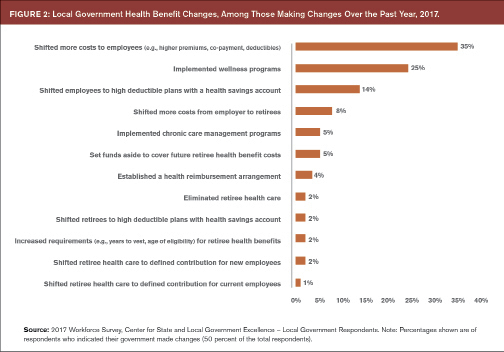
By Joshua Franzel and Gerald Young
In mid-2017, local government employment totaled 14,455,000 people, up 127,000 from the same time in 2016.1 To gauge the variety of changes this workforce has experienced, the Center for State and Local Government Excellence (SLGE) surveyed members of the International Public Management Association for Human Resources and the National Association of State Personnel Executives, as part of SLGE's ongoing, annual survey series.2
The survey covers a range of topics, from core workforce changes to recruitment and retention efforts to compensation and benefit changes, among other related subjects. This article discusses key findings of the 2017 survey from 230 respondents who are local government human resource professionals.
Workforce Changes
When surveyed in early 2017, 72 percent of local government respondents indicated that over the past year their government had hired employees and 46 percent hired contract or temporary employees (see Figure 1).
Regarding existing employees, 33 percent of respondents' governments had implemented broad-based pay increases over the past year, and 24 percent offered increases more narrowly for specific positions. Of responding HR officials, 24 percent noted that their government's retirement-eligible employees were delaying retirement, and 16 percent noted that employees were accelerating their anticipated retirement dates.
While the percentage of jurisdictions hiring was down slightly compared to a similar survey of local government human resource professionals over the past couple of years—in 2016, 77 percent hired employees and in 2015, 74 percent did so—it is above the rate that reported hiring employees in 2014 (67 percent).
Also, such negative workforce changes as hiring freezes, furloughs, and early retirement incentive programs have all been declining, consistently, year over year, from 2014 to 2017, with other such related changes as pay freezes, layoffs, and pay cuts also being in a general decline over this same period.
Recruitment and Retention
Overall, 68 percent of local government respondents believed the wage compensation offered by their governments was competitive with the labor market, and 93 percent indicated the same for benefit compensation. It is important to note that 52 percent of local government workers have a college degree or higher,3 in a labor market with an unemployment rate for those with this level of education at 2.4 percent.4
With this noted, the top positions that local governments continue to have a hard time filling are police officers, information technology professionals, engineers, utility workers, medical professionals, and skilled tradespeople. The top general skill sets needed for new hires were interpersonal, written communications, and technology.
Local government respondents indicated that the most effective recruitment approaches they used were online job advertising, posting on government websites, employee referrals, and social media. From previous SLGE research, the adoption and implementation of flexible work practices was found to assist local governments in recruiting.5 In 2017, 54 percent of local government respondents indicated that their government offered flexible scheduling (e.g., 4 days, 10 hours), and 41 percent offered flexible work hours, while a third (33 percent) did not have flexible work practices.
Compensation and Benefits
Over the past year, 17 percent of local governments made changes to employee retirement benefits. The most common changes were increasing employee and employer contributions for both current and new employees, making new hires' pension eligibility requirements more stringent, and decreasing new hires' pension benefits.
Half of all local governments (50 percent) made changes to health benefits over the past year. Shifting costs from the employer to employee in the form of higher premiums, copayments, and deductibles was the most common change, followed by the implementation of wellness programs, and shifting employees to high-deductible plans with a health savings account (see Figure 2).
Looking Forward
When local government human resource directors were asked about what workforce issues face their organizations, they responded that these were the most important:
• Recruitment and retention of qualified personnel with needed skills for public service (91 percent).
• Leadership development (75 percent).
• Staff development (75 percent).
• Retaining staff needed for core services (74 percent).
• Workforce succession planning (71 percent).
Not among the top responses by respondents but still noteworthy as potential indicators of emerging concerns: automation, millennial engagement, paid family leave, and pensions and other post-employment benefits.
Endnotes and Resources:
1 Bureau of Labor Statistics, Current Employment Statistics survey (National), June 2017 (preliminary) — June 2016.
2 SLGE online survey conducted March 31—April 29, 2017.
3 U.S. Census Bureau, Current Population Survey, 2016. By contrast, only 32 percent of private sector workers have a bachelor's degree of higher.
4 Bureau of Labor Statistics, Table A—4. Employment status of the civilian population 25 years and over by educational attainment, June 2017.
5 Center for State and Local Government Excellence and Local Government Research Collaborative, Local Government Workforce of Tomorrow, 2015.
Joshua Franzel is president and chief executive officer, and Gerald Young is senior research associate, Center for State and Local Government Excellence, Washington, D.C. (jfranzel@slge.org; gyoung@slge.org).


New, Reduced Membership Dues
A new, reduced dues rate is available for CAOs/ACAOs, along with additional discounts for those in smaller communities, has been implemented. Learn more and be sure to join or renew today!
